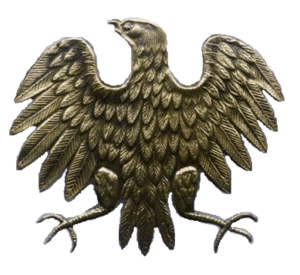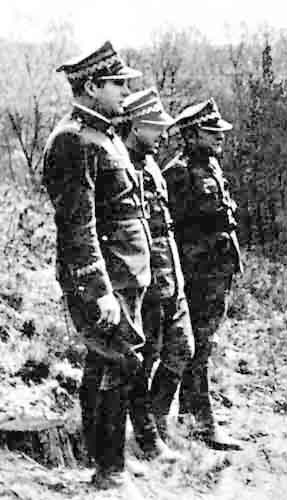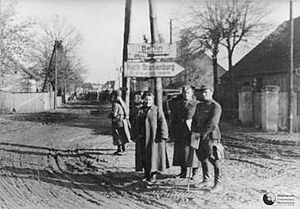Polish Armed Forces in the East facts for kids

The Polish Armed Forces in the East (in Polish: Polskie Siły Zbrojne na Wschodzie) were Polish military groups formed in the Soviet Union during World War II. These forces were made up of Poles who were in the Soviet Union at the time.
Two main Polish armies were created there, but they had different goals and leaders. One army, called Anders' Army, was loyal to the Polish government that was in exile (living outside Poland). The other, known as Berling's Army, was formed later and fought alongside the Soviet Union.
Anders' Army left the Soviet Union in 1942. It then joined the Western Allies and fought against Nazi German forces in places like Italy. The other army, the Polish People's Army, fought on the Eastern Front with the Soviets. It even reached the Battle of Berlin at the end of the war. After the war, the Polish People's Army became the main military force of communist-ruled Poland.
Anders' Army: A Journey to the West (1941–1942)
When the Soviets invaded Poland in September 1939, they said the Polish government no longer existed. This meant all agreements between the two countries were cancelled. However, things changed in 1941 after Germany attacked the Soviet Union. The British government became an ally of the Soviets and encouraged the Polish government-in-exile to do the same.
This led to new agreements between Poland and the Soviet Union in August 1941. Joseph Stalin, the Soviet leader, agreed to cancel parts of an earlier pact that divided Poland. This also meant that tens of thousands of Polish prisoners of war and hundreds of thousands of Polish citizens held in the USSR were set free.
The Polish Prime Minister, General Władysław Sikorski, chose General Władysław Anders to lead a new Polish army. General Anders himself had been a prisoner in the Soviet Union. This new army was formed in the USSR with the goal of fighting Germany alongside the Soviet Red Army.
This new group became known as Anders' Army. It started forming in the Buzuluk area, recruiting soldiers from Soviet prison camps. By the end of 1941, about 25,000 soldiers had joined. In 1942, the army moved to the Tashkent area and grew even larger.
Later in 1942, during the German attack on the Caucasus region, Stalin agreed to move the Polish forces. Anders' Army traveled through Iran to the Middle East. About 77,000 soldiers and 41,000 Polish civilians left the USSR. Anders' Army then came under the command of the British government. It became a big part of the Polish Armed Forces in the West, known as the Polish Second Corps. This corps went on to fight bravely in the Italian Campaign, including the famous Battle of Monte Cassino.
Berling's Army: Fighting on the Eastern Front (1943–1945)
After Anders' Army left the Soviet Union, relations between the Soviets and the Polish government-in-exile worsened. The Soviets decided to take more control over the remaining Polish people and military potential in the USSR. In 1943, the Soviets even stopped diplomatic relations with the Polish government after news of the Katyn massacre became known.
In June 1943, a new organization called the Union of Polish Patriots (ZPP) was created in Moscow. This group was led by Polish communists and helped Polish citizens in the Soviet Union. It was headed by Wanda Wasilewska, who supported the Soviet Union.
At the same time, thanks to Wasilewska and Zygmunt Berling, a new army was formed. This was the Polish People's Army (in Polish: Ludowe Wojsko Polskie, or LWP). Its first unit, the Polish 1st Tadeusz Kościuszko Infantry Division, was ready by summer 1943. In August, it grew into the Polish 1st Corps, led by General Berling. Other important commanders included General Karol Świerczewski.
This division was sent to the Eastern Front in September 1943. Its first major battle was the Battle of Lenino. By March 1944, the corps had grown to over 30,000 soldiers and had more tanks and vehicles. In mid-March 1944, it was reorganized into the First Polish Army.
Other Polish army units were also created by the Soviets on the Eastern Front, including the Second Polish Army (formed in 1945). These forces were led by Soviet commanders. Many Polish officers had been killed or left with Anders' Army, so about 40% of the officers and engineers in the Polish First and Second Armies were Soviet. Special political officers, mostly Soviets, also watched over the Polish soldiers.
The First Army entered Poland from Soviet territory in summer 1944. It fought in battles during the Soviet crossing of the Vistula River. In September 1944, units of the First Army were involved in heavy fighting during the Warsaw Uprising. They crossed the Vistula after capturing Warsaw's eastern Praga district, but they suffered many losses.
After finally taking control of Warsaw in January 1945, the First Army took part in the Vistula–Oder Offensive. It then fought in Pomerania, breaking through the strong Pomeranian Wall defenses. In March, it captured the heavily fortified city of Kolberg. In April–May 1945, the First Army joined the Soviet invasion of Germany and helped in the final capture of Berlin.
The Second Army was ready for battle in January 1945. During the Soviet invasion of Germany, it suffered very heavy losses at the Battle of Bautzen. Later, it took part in the Prague Offensive, which was the last big Soviet operation of World War II in Europe.
See also
- Polish Armed Forces in the West
- Polish contribution to World War II
- 1st Czechoslovak Army Corps in the Soviet Union
- Polish Armed Forces (Second Polish Republic)
- Armia Ludowa
- Gwardia Ludowa
- First Polish Army (1944–1945)
- Polish People's Army
- Polish Combatants' Association (United States)
- Western betrayal
- Polish British
- Civilian Labor Group
- Sikorski's tourists
- Bataliony Chłopskie
- History of Poland (1939–1945)
- Northern Group of Forces
- Soviet invasion of Poland
- History of Poland (1945–1989)
- Soviet repressions of Polish citizens (1939–1946)





